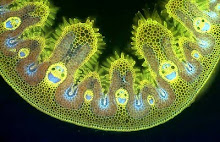Unusual fruits, strawberries - in more ways than one. In many edible fruits the edible part is formed from the succulent ovary wall that encloses the seed (the fleshy part of a peach, for example) but in strawberries each one of the ‘seeds’ on the outside of the fruit is, in botanical terms, a fruit – a seed inside a tough, dry ovary wall – known as an achene - and the edible part of the fruit is formed from the swollen receptacle that they grow on.
The cultivated strawberry Fragaria x ananassa has a fascinating history. It’s an accidental hybrid between F. chiloensis, which grows along the western seaboard of North and South America as far south as Chile, and F. virginiana which is a woodland species mostly found in eastern North America. Both were eaten by indigenous peoples there before they were brought to Europe in the mid-16th. century, where they were cultivated separately. Their fruits were larger than native European species which made them desirable, but the key event in modern strawberry history was a chance cross-pollination between these two species when they were grown together in France. The offspring was the even larger fruited F. x ananassa, originally known as the pineapple or pine strawberry and first described in 1759. Modern strawberries are descendants of this original cross, probably performed by a bee, but perhaps the most interesting aspect of this accident is that, before it arose, varieties of both parents were known that had a wide range of flavours. As late as 1870, American varieties of the parents were known with flavours that included apple, apricot, cherry, grape, mulberry, raspberry and pineapple. It just so happened that the bee that produced the accidental hybrid must have transferred pollen between strawberry-flavoured parents; had it flown between parents with any of the other flavours, modern strawberries would not be strawberry flavoured – spectators at Wimbledon might have been feasting on raspberry- or cherry-flavoured ‘strawberries’. The flavour of strawberries is biochemically complex and a small change in the constituent compounds is all that’s need for a shift in flavour from strawberry flavour to – say – raspberry flavour. Sadly, almost all those other flavours in the old parental species, which have long disappeared from cultivation, have been lost although I think pineapple-flavoured wild strawberries are still available from a few seed suppliers. You often hear people complain about the insipid taste of modern strawberry varieties grown under intensive cultivation techniques; just imagine how diverse their tastes might have been if all those old parental varieties had been conserved and used in modern breeding programmes. There’s much more fascinating information about the history of strawberries in the Evolution of Crop Plants by N.W. Simmonds, published by Longman in 1976 (ISBN 0 582 44496 9), out of print but obtainable from libraries.














